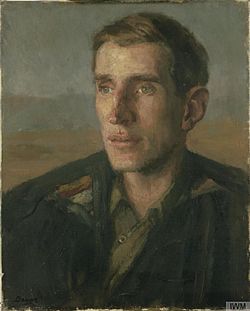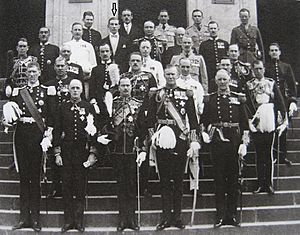Wilfred Thesiger facts for kids
Quick facts for kids
Sir Wilfred Thesiger
|
|
|---|---|

1944 portrait by Anthony Devas
|
|
| Born |
Wilfred Patrick Thesiger
3 June 1910 |
| Died | 24 August 2003 (aged 93) Croydon, London, England
|
| Nationality | English |
| Alma mater | Magdalen College, Oxford |
| Known for | Exploration, Writing, Photography |
|
Notable work
|
Arabian Sands The Marsh Arabs |
| Military career | |
| Allegiance | United Kingdom |
| Service/ |
British Army |
| Years of service | 1940–1943 |
| Rank | Major |
| Unit | Sudan Defence Force Gideon Force Special Air Service |
| Battles/wars | Second World War |
Sir Wilfred Patrick Thesiger (born June 3, 1910 – died August 24, 2003) was a famous British explorer, writer, and military officer. People in Arabia also knew him as Mubarak bin Landan, which means "the blessed one of London."
He wrote popular travel books like Arabian Sands (1959). This book describes his amazing journey across the Empty Quarter desert on foot and by camel. He also wrote The Marsh Arabs (1964), about his time living with the Marsh Arabs in Iraq.
Contents
Early Life and Education
Wilfred Thesiger was born in Addis Ababa, Ethiopia. His father, Wilfred Gilbert Thesiger, was a British diplomat there. For much of his early childhood, Wilfred and his younger brother were the only European children in Addis Ababa.
He went to school in England at St. Aubyn's School, then Eton College, and later Magdalen College, Oxford University. At Oxford, he studied history. He was also a talented boxer and captained the Oxford boxing team for four years.
Adventures and Explorations

In 1930, Thesiger returned to Africa. He was invited by Emperor Haile Selassie to his coronation in Ethiopia. He went back again in 1933 to lead an expedition. This trip, partly funded by the Royal Geographical Society, explored the Awash River. During this journey, he was one of the first Europeans to visit the Aussa Sultanate and Lake Abbe.
From 1935 to 1940, Thesiger worked in Sudan. He was stationed in areas like Darfur.
World War II Service
When World War II began, Thesiger joined the Sudan Defence Force. He helped the Ethiopian people fight against the Italian forces who had taken over their country. He received a special award, the Distinguished Service Order, for capturing an Italian military base and 2,500 soldiers.
Later, he served with special forces units like the Special Air Service in North Africa. He became a Major. From 1943 to 1945, he advised the Crown Prince of Ethiopia.
Journeys Across Deserts and Marshes
After World War II, Thesiger continued his travels. He explored Arabia, lived for several years in the marshes of Iraq, and visited countries like Iran, Kurdistan, and Pakistan. He also spent many years living in northern Kenya.
He is most famous for his trips across Arabia. In 1945, he was hired to find locust breeding grounds in southern Arabia. This led him to cross the vast Rub' al Khali desert, also known as the Empty Quarter, twice. He rode camels with his Bedu guides. These areas were often dangerous due to local tribes and rulers who didn't want foreigners there.
His first big desert crossing started in October 1946. He left Salalah in Oman and traveled to the Mughshin Oasis. He continued with four Bedouin companions. He reached the Liwa Oasis in the Emirate of Abu Dhabi in December. He then visited Abu Dhabi town before returning to Salalah in February 1947.
His second crossing began in December 1947. He traveled through Yemen to the Liwa Oasis and then to Abu Dhabi town. He arrived there in March 1948. Thesiger did not like the idea of oil exploration in these areas. He believed that finding oil would destroy the traditional way of life for the Bedouin people. However, he sometimes accepted money from oil companies to fund his expeditions. Thesiger was knighted in 1995.
His two most famous travel books are Arabian Sands (1959) and The Marsh Arabs (1964). Arabian Sands tells the story of his travels in the Empty Quarter and describes the disappearing way of life of the Bedu people. The Marsh Arabs is about the Madan people, who live in the marshlands of southern Iraq.
In 1998, he published Among the Mountains. This book shares details of his travels through Afghanistan and Northern Pakistan.
Thesiger took many photographs during his journeys. He gave his huge collection of 38,000 photo negatives to the Pitt Rivers Museum in Oxford, England.
His Legacy
In England, Thesiger was known for his travels, writings, and military service. People who met him often found him to be a very traditional person. Among the Arabian people, he was respected as a brave adventurer. One of his travel companions, Salim bin Ghabaisha, described him as "loyal, generous, and afraid of nothing."
Awards
- Commander of the Order of the Star of Ethiopia, 1930
- Companion of the Distinguished Service Order, 1941
- Founder's Medal, Royal Geographical Society, 1948
- Lawrence of Arabia Memorial Medal, Royal Society for Asian Affairs, 1955
- Livingstone Medal, Royal Scottish Geographical Society, 1962
- W. H. Heinemann Award, 1964
- Royal Society of Literature, 1965
- Burton Memorial Medal, Royal Asiatic Society, 1966
- Honorary DLitt, Leicester, 1967
- Commander of the Order of the British Empire, 1968
- Fellow Royal Society of Literature, 1982
- Honorary Fellow British Academy, 1982
- Honorary DLitt, University of Bath, 1992
- Knight Commander of the Order of the British Empire, 1995
- Abu Dhabi Awards, 2008
Books by Wilfred Thesiger
- Arabian Sands (1959)
- The Marsh Arabs (1964)
- The Last Nomad (1979)
- The Life of My Choice (1987)
- Visions of a Nomad (1987)
- My Kenya Days (1994)
- The Danakil Diary: Journeys through Abyssinia, 1930–34 (1996)
- Among the Mountains: Travels Through Asia (1998)
- Crossing the Sands (2000)
- My Life and Travels (anthology) (2002)
- A Vanished World (2001)
See also
 In Spanish: Wilfred Thesiger para niños
In Spanish: Wilfred Thesiger para niños
- Salim bin Ghabaisha
- Jebel Hafeet


